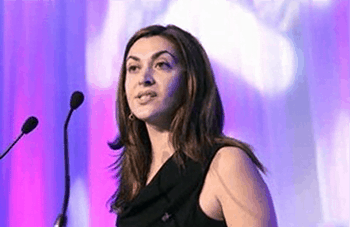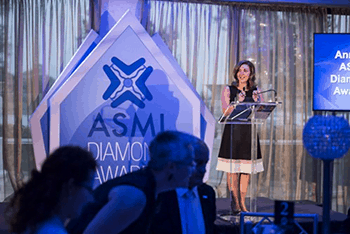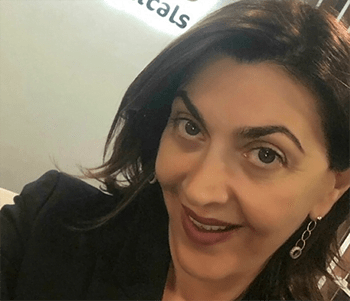Be authentic and live your values
Filomena Maiese | Executive Director
 Critically ill with pneumonia, I woke up struggling to breathe in intensive care at Concord Hospital on Christmas Eve a few years ago. Spending six days day watching the hands of the clock on the wall creeping so slowly along its path, I wondered if the battery was slowly going flat. All the minutiae I used to sweat and stress over seemed insignificant as I struggled to breathe through the respirator. I was run into the ground and let the persistent flu escalate so far that it became life threatening. My recovery was long and my body was weak. Yet my mind was so clear at the same time. It was like my other senses shut down to create mental stillness and clarity.
Critically ill with pneumonia, I woke up struggling to breathe in intensive care at Concord Hospital on Christmas Eve a few years ago. Spending six days day watching the hands of the clock on the wall creeping so slowly along its path, I wondered if the battery was slowly going flat. All the minutiae I used to sweat and stress over seemed insignificant as I struggled to breathe through the respirator. I was run into the ground and let the persistent flu escalate so far that it became life threatening. My recovery was long and my body was weak. Yet my mind was so clear at the same time. It was like my other senses shut down to create mental stillness and clarity.
Needing to fill the long days in the hospital, I asked my husband to bring writing paper and a pen with him next time he visited. From the moment the pen hit the paper I found myself writing a stream of consciousness. It freely flowed out of me like never before. I do not know whether it was the drugs or a series of aha moments brought about by mental clarity, but I was writing about my life, the need to be authentic, true to myself, what my real calling was, and deciding what I would and would not do from that day on . . . little did I know at the time I was writing my first book.
Gaining clarity
As soon as I graduated from a commerce degree at the University of New South Wales in the 1990s I started writing a journal. Starting in an entry-level marketing role, I was on my way, the future looked bright and I was full of hope. But transitioning to corporate life was hard. There was no-one to confide in to help me bring meaning to what I was experiencing.
Whenever things got tough or something big happened at work, I would go home and write about it in my journal. This process enabled me to download and reconcile, better understand what was going on and reflect on how I could do better next time. It was a ritual I commenced around unpacking issues and trying to find the lessons in them. Feeling better afterwards, I reflected on what I had learned from the experience and what I would do differently the next day. The journal helped me to decipher ambiguity and writing gave me clarity around what was going on in my work life. It was like having a virtual mentor.
It was not until I returned home from hospital that I dusted off the journal and read it. Twenty-five years down the track I looked at it with a different lens—it was a wake up call. Realising that I was at a juncture I decided to reset. It made me question what I was doing with my life and where I was going. It was almost like a catalogue that helped me reconcile the first half of my life to give me clarity around what I wanted for the second half. Reading back on all the lessons I had learned, I realised the journal contained some tremendous insights that I thought I would love to share with others to help them navigate corporate life. Publishing a series of blogs was my first step then I stitched them together creating a sort of chapter…and that is how it evolved into a book. ‘Maybe,’ I thought at the time, ‘these stories could help others.’
I had a strong desire to share my learnings with young people who are starting out in their careers. I wished that I had someone to mentor me when I was young. Someone to learn from, a sage. That is why I feel so passionate about it now as a way forward. If I had had someone guiding me, steering me in the right direction, someone providing a bit of counsel, I may have navigated through issues more effectively, staying true to my values. Instead, I learned the hard way with lots of painful lessons. Here are some of the lessons I would like to share.
The blue-chip dream
When I graduated from UNSW, I aspired to be a business director heading up a team in a blue-chip multinational. The big role with the big title in the big company. I had linked title and rank with success. I would show the doubters who looked down at me that I could do it. In the following years I worked hard, put in long hours, talked the talk, played the games, climbed the corporate ladder. Then one day I was offered the role I had aspired to for so long . . . or so I thought.
Once I got there, settled in, lived the role and lived my dream I absolutely hated it. Even though it paid big bucks, had great kudos and catapulted me into the limelight—I loathed it. The big fancy company was so big, most of my time was spent on presenting, politicking, justifying, and explaining up, down and across the business. There were too many decision makers in this massive bureaucratic organisation. It was impossible to make a meaningful difference or add value. I felt like a cog in a very big machine.
 Every year we restructured, cutting to the bone. We perpetually fired good people to hit unrealistic headcount targets. I had gone through the process so many times I reached the point of autopilot when restructure time came around again. I went through the motions like an automaton, telling people their position had been made redundant and that they no longer had a job. It is emotionally draining at the best of times, but I did it every year—so many times that I switched to autopilot. I remember one round of restructuring when I had to tell a lovely young woman—a single mum who had no other source of income who was good at what she did—I had to tell her she no longer had a job even though she was a great contributor. But I had to do it as I had instructions from the top.
Every year we restructured, cutting to the bone. We perpetually fired good people to hit unrealistic headcount targets. I had gone through the process so many times I reached the point of autopilot when restructure time came around again. I went through the motions like an automaton, telling people their position had been made redundant and that they no longer had a job. It is emotionally draining at the best of times, but I did it every year—so many times that I switched to autopilot. I remember one round of restructuring when I had to tell a lovely young woman—a single mum who had no other source of income who was good at what she did—I had to tell her she no longer had a job even though she was a great contributor. But I had to do it as I had instructions from the top.
The longer I stayed in the role, the more foreign my behaviour became. I started to see a side of me that I had not seen before and I did not like—I was morphing into a corporate animal to survive there. It was like I was looking at myself from a distance thinking, ‘Who are you?’ One day I thought, ‘This is not me, I don’t want to be this way.’ The company asked me to do things that were way out of sync with my values. I had to do them because I was running the business, I was responsible for the bottom line. ‘I don’t want to do this,’ I thought, ‘it’s not caring, it’s not right, its putting business before people.’ Upon reflection, I was horrified with the behaviours I was starting to demonstrate in order to survive in the culture, play the politics. It was not the ‘me’ I wanted to be. I was rude, grumpy, short with people, dogmatic, aggressive and neurotic. I knew this behaviour was not the real me.
It was most likely that this internal conflict made me sick. As I lay in the hospital bed, I started to look inward, floating above my body. I realised that I didn’t like what I had become. I did not like myself. I did not like my behaviour. ‘It’s not who I am,’ I thought, ’it’s not who I want to be.’ There was a mismatch between the culture and my values, and the role and organisation I was in—I didn’t want to be there anymore.
 I had put so much passion and energy into getting there and achieving what I thought I wanted, but when I finally reached my goal it was not what I had expected. I had to make a choice at that point—I could keep living the façade of the dream job, the dream company and be miserable to the point of depression, exhaustion and stress times infinity, or I could walk away and follow what makes me happy . . . but I had to identify what made me happy. It took a while to work through that in terms of reconciling what I enjoyed, what I was good at, where I could demonstrate a value-add, what kind of roles and what kind of companies. Where I landed was 360 degrees from where I started—definitely not the big boxing ring of a multinational or large corporate, but a smaller more entrepreneurial organisation, a senior role where I had autonomy. So I quit. I just walked away from the role I had aspired to attain over so many years.
I had put so much passion and energy into getting there and achieving what I thought I wanted, but when I finally reached my goal it was not what I had expected. I had to make a choice at that point—I could keep living the façade of the dream job, the dream company and be miserable to the point of depression, exhaustion and stress times infinity, or I could walk away and follow what makes me happy . . . but I had to identify what made me happy. It took a while to work through that in terms of reconciling what I enjoyed, what I was good at, where I could demonstrate a value-add, what kind of roles and what kind of companies. Where I landed was 360 degrees from where I started—definitely not the big boxing ring of a multinational or large corporate, but a smaller more entrepreneurial organisation, a senior role where I had autonomy. So I quit. I just walked away from the role I had aspired to attain over so many years.
 Determined that the next role would align with my values and enable me to live authentically I looked around for sometime. When it arrived—a senior director role in an industry association—I was astonished. It came out of the blue, falling into my lap. It was perfect. I was my happiest in that role because I could live my values, be authentic and work autonomously. I had flexibility, did strategy as well as operational work, headed up a small dynamic team and made a significant difference. I was there six years and knew when it was time to step out again. discover new opportunities and grow. But I took my time, guided by my intuition to look for roles that matched my value system. I looked for roles that enabled me to be authentic about who I am and what I could contribute and less about ego, less about titles, profile and that sort of thing—more about adding value, giving back and making a difference. And do you know what? I found a role that totally aligns with my values and beliefs and I absolutely love it. I have never been happier.
Determined that the next role would align with my values and enable me to live authentically I looked around for sometime. When it arrived—a senior director role in an industry association—I was astonished. It came out of the blue, falling into my lap. It was perfect. I was my happiest in that role because I could live my values, be authentic and work autonomously. I had flexibility, did strategy as well as operational work, headed up a small dynamic team and made a significant difference. I was there six years and knew when it was time to step out again. discover new opportunities and grow. But I took my time, guided by my intuition to look for roles that matched my value system. I looked for roles that enabled me to be authentic about who I am and what I could contribute and less about ego, less about titles, profile and that sort of thing—more about adding value, giving back and making a difference. And do you know what? I found a role that totally aligns with my values and beliefs and I absolutely love it. I have never been happier.
Turmoil is ‘re-alignment’ in disguise
Looking back, I have noticed a common thread throughout my journey—whenever there has been a lack of alignment between what I am doing and my values—a values violation—the going gets tough and I crash and burn. I feel like the universe creates havoc for me when there is an inconsistency between what I am doing and my core beliefs. This reinforces for me the need to live my values, making choices around my beliefs instead of chasing pipedreams that often do not end up aligning with my values.
Although we try to avoid turmoil, illness and pain, they are good lessons. I have gained so many tremendous insights through these experiences. As the saying goes—the harder the fall the higher the bounce. I now intend to be more purposeful, more discerning around my choices, take control and put boundaries around what I will and will not do in the future. From now on I will live my values, be authentic and true to myself.
If you would like Share your life story to write your memoir or life story please call Gabriella on 0408 256 381 or email: [email protected]




